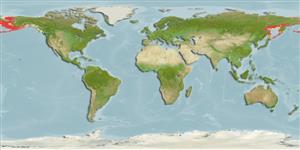>
Perciformes/Zoarcoidei (Eelpouts and pricklebacks) >
Lumpenidae (Eel pricklebacks)
Etymology: Acantholumpenus: Greek, akantha = thorn + Latin, lumpus = to look disagreable, 1545 (Cyclopterus lumpus) and Latin, lumpus = a uncouth-looking spiny fish of a leaden blue colour; 1545 (Ref. 45335).
More on author: Gilbert.
Environment: milieu / climate zone / depth range / distribution range
Ecologia
marinhas; estuarina demersal; intervalo de profundidade 0 - 200 m (Ref. 56557). Polar; 70°N - 44°N, 134°E - 120°W
North Pacific: Hokkaido, Japan to the Okhotsk and Bering seas. Arctic Ocean: Arctic coast of Canada.
Tamanho / Peso / Idade
Maturity: Lm ? range ? - ? cm
Max length : 70.0 cm SL macho/indeterminado; (Ref. 559); Idade máx. registada: 12 anos (Ref. 56557)
Espinhos dorsais (total): 68 - 76; Raios dorsais moles (total): 0; Espinhos anais 2; Raios anais moles: 41 - 48. Caudal fin slightly grayish without dark bands; roof of oral cavity with a dark region (Ref. 559). Spines of pelvic and anal fins rigid and easily discernible from other soft rays (Ref. 559). Eye diameter less than snout length (Ref. 559).
Found over mud and sand bottoms to depths of about 56 meters; often in brackish waters (Ref. 51666). Benthic; feeds on worms, crustaceans, sea urchins and molluscs (Ref. 58426).
Life cycle and mating behavior
Maturidade | Reprodução | Desova | Ovos | Fecundidade | Larvas
Robins, C.R., R.M. Bailey, C.E. Bond, J.R. Brooker, E.A. Lachner, R.N. Lea and W.B. Scott, 1991. Common and scientific names of fishes from the United States and Canada. Am. Fish. Soc. Spec. Publ. (20):183 p. (Ref. 3814)
Categoria na Lista Vermelha da IUCN (Ref. 130435)
Ameaça para o homem
Harmless
Utilização humana
Mais informação
ReferênciasAquaculturaPerfil para aquaculturaEstirpesGenéticaElectrophoresesHereditariedadeDoençasProcessamentoNutrientsMass conversion
ColaboradoresFotografiasStamps, Coins Misc.SonsCiguateraVelocidadeTipo de nataçãoÁrea branquialOutras referênciasCérebrosVisão
Ferramentas
Relatórios especiais
Descarregue XML
Fontes da internet
Estimates based on models
Preferred temperature (Ref.
123201): -1.5 - 5.6, mean 0.2 °C (based on 1195 cells).
Phylogenetic diversity index (Ref.
82804): PD
50 = 1.0000 [Uniqueness, from 0.5 = low to 2.0 = high].
Bayesian length-weight: a=0.00263 (0.00144 - 0.00479), b=2.91 (2.75 - 3.07), in cm total length, based on LWR estimates for this species & (Sub)family-body (Ref.
93245).
Nível Trófico (Ref.
69278): 3.1 ±0.2 se; based on diet studies.
Resiliência (Ref.
120179): Baixo, tempo mínimo de duplicação da população 4,5 - 14 anos (Preliminary K or Fecundity.).
Fishing Vulnerability (Ref.
59153): Moderate to high vulnerability (54 of 100).
